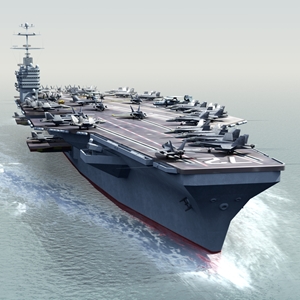With continued scrutiny directed toward the federal budget, lawmakers have been eyeing a reduction to the nation's fleet of aircraft carriers for some time. The ships cost billions to construct and billions more to maintain year in and year out. Despite their cost, however, carriers have long been leaned on strategically as one of the main pillars of America's military prowess at sea. As a result, the U.S. Navy just narrowly avoided losing one of its aircraft carriers to the scrap yard.
The cost of a carrier
The Wall Street Journal reported that the USS George Washington, a Nimitz-class supercarrier, had been planned for decommissioning and deconstruction after a review of the Navy's finances last year, but intervention from the White House saved the ship from its fate. The review was lead by Secretary of Defense Chuck Hagel, who found that the Navy's operational capabilities would not be seriously impacted by decreasing the number of carriers from 11 to the proposed 10. The new number would still have equaled the combined carrier strength of seven other countries.
The George Washington was initially commissioned July 4, 1992 and is based out of Yokosuka, Japan, according to the Navy. Powered by two nuclear reactors, the George Washington and similar ships usually have a lifespan of 50 years, but require refueling and widespread maintenance at some point during their operational careers. The George Washington is scheduled for refueling in 2016 and the price tag of that work is steep at nearly $4.7 billion. Amid budget cuts to agencies across the board, Hagel recommended that the George Washington be scrapped.
Sail to the chief
Amid the controversy, The Wall Street Journal speculated that instead of allowing an aircraft carrier to be retired under a Democratic administration and before an election cycle, the White House allocated the necessary funds for the refurbishment of the George Washington to the military's budget. This decision was reportedly made by White House officials interested in avoiding a political fight with Congressmen who would have blocked any Executive effort to retire a carrier. Rather than see a proposal mired on Capitol Hill, the decision was made to keep the carrier in active service and avoid criticisms in the process.
Support for ships
The intervention has more benefits than political gain, however.
David Berteau is a defense analyst with the non-profit Center for Strategic and International Studies and he recommended that instead of retiring the relatively young George Washington, one of the older ships be considered. The oldest carrier in service today is the USS Nimitz, commissioned in 1975. As the Navy is currently working under a plan to build a new aircraft carrier every five years, Berteau said that a move towards a constantly modernizing fleet would not only help with military force, but any halt in construction for financial purposes would make it more difficult to build ships in the future.
"Once you break the production of carriers, you will not have a carrier industrial base," Berteau told The Wall Street Journal.
Rep. Randy Forbes (R., Va.) insisted that a reduction in aircraft carrier strength could spell disaster for the Navy's military capabilities.
"The aircraft carrier remains the centerpiece of American sea power and is fundamental to a national security policy based on forward deployed presence and power," he told the Wall Street Journal.
Sen. Tim Kaine (D., Va.) agreed with the Republican representative, saying that any reduction in carrier strength would seen be by allies and enemies alike as an unwillingness for the U.S. to engage itself in military actions in the future.

